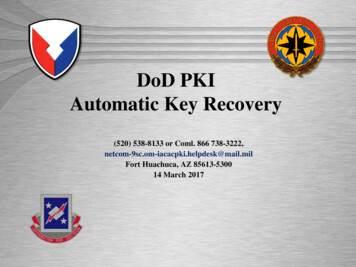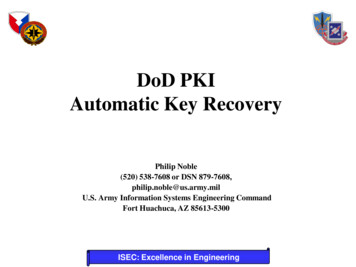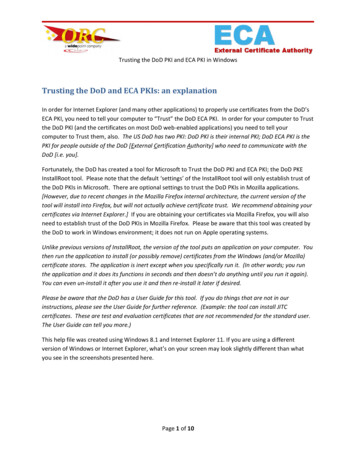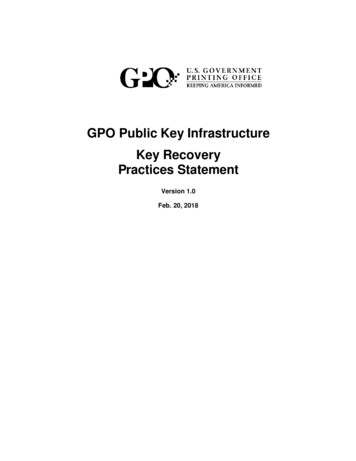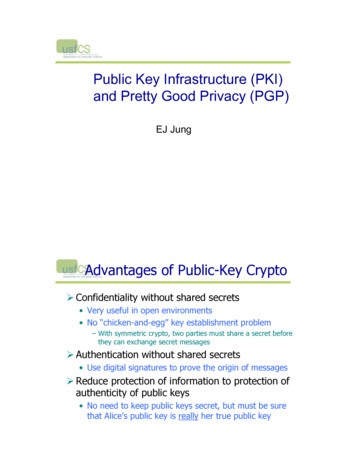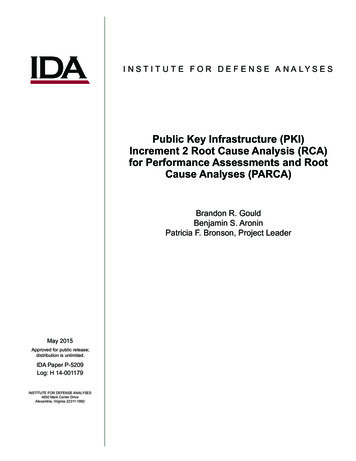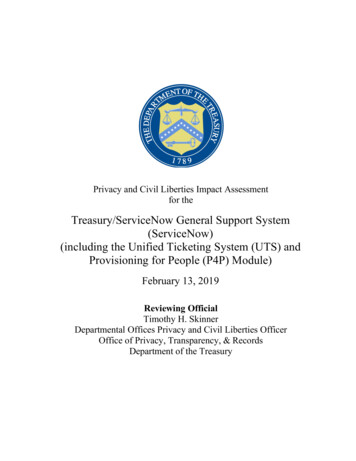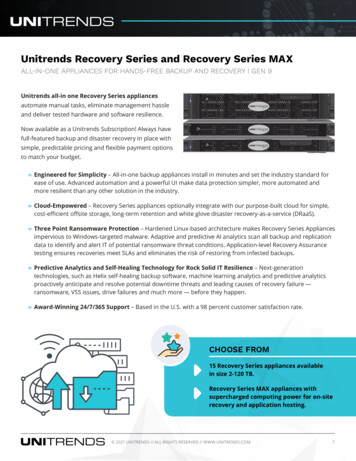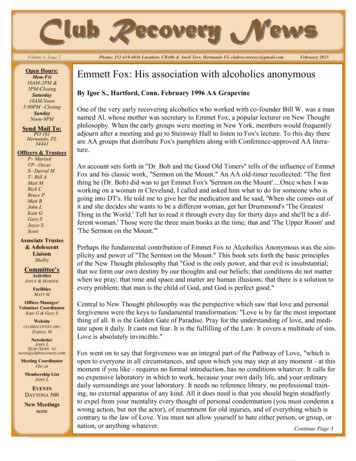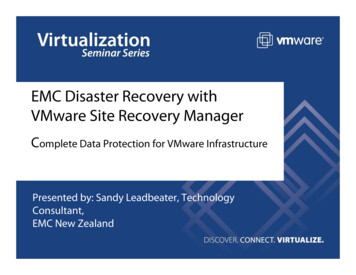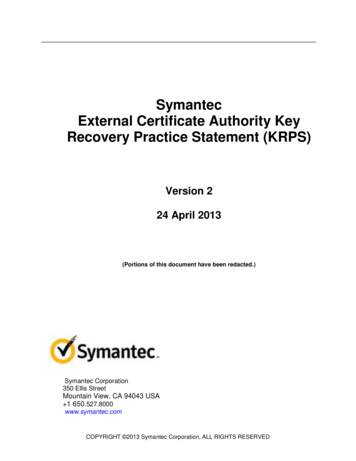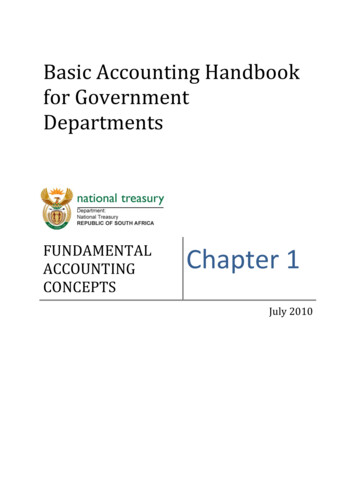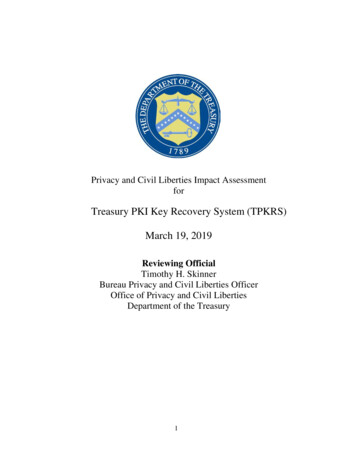
Transcription
Privacy and Civil Liberties Impact AssessmentforTreasury PKI Key Recovery System (TPKRS)March 19, 2019Reviewing OfficialTimothy H. SkinnerBureau Privacy and Civil Liberties OfficerOffice of Privacy and Civil LibertiesDepartment of the Treasury1
Section 1: IntroductionIt is the policy of the Department of the Treasury (“Treasury” or “Department”) and its Bureausto conduct a Privacy and Civil Liberties Impact Assessment (“PCLIA”) when personallyidentifiable information (“PII”) is maintained in a system or by a project. PCLIAs are requiredfor all systems and projects that collect, maintain, or disseminate PII, regardless of the manner inwhich the information is retrieved.This assessment is being completed pursuant to Section 208 of the E-Government Act of 2002(“E-Gov Act”), 44 U.S.C. § 3501, Office of the Management and Budget (“OMB”)Memorandum 03-22, “OMB Guidance for Implementing the Privacy Provisions of the EGovernment Act of 2002,” and Treasury Directive 25-07, “Privacy and Civil Liberties ImpactAssessment (PCLIA),” which requires Treasury Offices and Bureaus to conduct a PCLIA before:1. developing or procuring information technology (“IT”) systems or projects that collect,maintain, or disseminate PII from or about members of the public, or2. initiating a new collection of information that: a) will be collected, maintained, ordisseminated using IT; and b) includes any PII permitting the physical or onlinecontacting of a specific individual, if identical questions have been posed to, or identicalreporting requirements imposed on, 10 or more persons. Agencies, instrumentalities, oremployees of the federal government are not included.This PCLIA provides the following information regarding the system or project:(1) an overview of its purpose and functions;(2) a description of the information collected;(3) a description of the how information is maintained, used, and shared;(4) an assessment of whether the system or project is in compliance with federalrequirements that support information privacy; and(5) an overview of the redress/complaint procedures available to individuals who may beaffected by the use or sharing of information by the system or project.A PCLIA was not previously conducted for this system.Section 2: DefinitionsAgency – means any entity that falls within the definition of the term “executive agency”' as defined in 31 U.S.C. §102.Certifying Official – The Bureau Privacy and Civil Liberties Officer(s) who certify that all requirements in TD andTD P 25-07 have been completed so a PCLIA can be reviewed and approved by the Treasury Deputy AssistantSecretary for Privacy, Transparency, and Records.Collect (including “collection”) – means the retrieval, receipt, gathering, or acquisition of any PII and its storage orpresence in a Treasury system. This term should be given its broadest possible meaning.Contractors and service providers – are private companies that provide goods or services under a contract with theDepartment of the Treasury or one of its bureaus. This includes, but is not limited to, information providers,2
information processors, and other organizations providing information system development, information technologyservices, and other outsourced applications.Data mining – means a program involving pattern-based queries, searches, or other analyses of 1 or more electronicdatabases, where – (a) a department or agency of the federal government, or a non-federal entity acting on behalf ofthe federal government, is conducting the queries, searches, or other analyses to discover or locate a predictivepattern or anomaly indicative of terrorist or criminal activity on the part of any individual or individuals; (b) thequeries, searches, or other analyses are not subject-based and do not use personal identifiers of a specific individual,or inputs associated with a specific individual or group of individuals, to retrieve information from the database ordatabases; and (c) the purpose of the queries, searches, or other analyses is not solely – (i) the detection of fraud,waste, or abuse in a government agency or program; or (ii) the security of a government computer system.Disclosure – When it is clear from its usage that the term “disclosure” refers to records provided to the public inresponse to a request under the Freedom of Information Act (5 U.S.C. § 552, “FOIA”) or the Privacy Act (5 U.S.C.§ 552a), its application should be limited in that manner. Otherwise, the term should be interpreted as synonymouswith the terms “sharing” and “dissemination” as defined in this manual.Dissemination – as used in this manual, is synonymous with the terms “sharing” and “disclosure” (unless it is clearfrom the context that the use of the term “disclosure” refers to a FOIA/Privacy Act disclosure).E-G overnment – means the use of digital technologies to transform government operations to improveeffectiveness, efficiency, and service delivery.Federal information system – means a discrete set of information resources organized for the collection,processing, maintenance, transmission, and dissemination of information owned or under the control of a federalagency, whether automated or manual.Final Rule – After the NPRM comment period closes, the agency reviews and analyzes the comments received (ifany). The agency has the option to proceed with the rulemaking as proposed, issue a new or modified proposal, orwithdraw the proposal before reaching its final decision. The agency can also revise the supporting analysescontained in the NPRM (e.g., to address a concern raised by a member of the public in response to the NPRM).Government information – means information created, collected, used, maintained, processed, disseminated, ordisposed of by or for the federal government.Individual – means a citizen of the United States or an alien lawfully admitted for permanent residence. If aquestion does not specifically inquire about or an issue does not clearly involve a Privacy Act system of records, theterm should be given its common, everyday meaning. In certain contexts, the term individual may also includecitizens of other countries who are covered by the terms of an international or other agreement that involvesinformation stored in the system or used by the project.Information – means any representation of knowledge such as facts, data, or opinions in any medium or form,regardless of its physical form or characteristics. This term should be given the broadest possible meaning. Thisterm includes, but is not limit to, information contained in a Privacy Act system of records.Information technology (IT) – means any equipment or interconnected system or subsystem of equipment, used inthe automatic acquisition, storage, analysis, evaluation, manipulation, management, movement, control, display,switching, interchange, transmission, or reception of data or information by the executive agency, if the equipmentis used by the executive agency directly or is used by a contractor under a contract with the executive agency thatrequires the use: (i) of that equipment; or (ii) of that equipment to a significant extent in the performance of a serviceor the furnishing of a product. It includes computers, ancillary equipment (including imaging peripherals, input,output, and storage devices necessary for security and surveillance), peripheral equipment designed to be controlledby the central processing unit of a computer, software, firmware and similar procedures, services (including supportservices), and related resources; but does not include any equipment acquired by a federal contractor incidental to afederal contract. Clinger-Cohen Act of 1996, 40 U.S.C. § 11101(6).3
Major Information system – embraces “large” and “sensitive” information systems and means “a system orproject that requires special management attention because of its importance to an agency mission; its highdevelopment, operating, or maintenance costs; or its significant role in the administration of agency programs,finances, property, or other resources.” OMB Circular A-130, § 6.u. This definition includes all systems that containPII and are rated as “MODERATE or HIGH impact” under Federal Information Processing Standard 199.National Security systems – a telecommunications or information system operated by the federal government, thefunction, operation or use of which involves: (1) intelligence activities, (2) cryptologic activities related to nationalsecurity, (3) command and control of military forces, (4) equipment that is an integral part of a weapon or weaponssystems, or (5) systems critical to the direct fulfillment of military or intelligence missions, but does not includesystems used for routine administrative and business applications, such as payroll, finance, logistics, and personnelmanagement. Clinger-Cohen Act of 1996, 40 U.S.C. § 11103.Notice of Proposed Rule Making (NPRM) – the Privacy Act (Section (J) and (k)) allow agencies to use therulemaking process to exempt particular systems of records from some of the requirements in the Act. This processis often referred to as “notice-and-comment rulemaking.” The agency publishes an NPRM to notify the public thatthe agency is proposing a rule and provides an opportunity for the public to comment on the proposal before theagency can issue a final rule.Personally Identifiable Information (PII) –any information that can be used to distinguish or trace an individual’sidentity, either alone or when combined with other personal or identifying information that is linked or linkable to aspecific individual.Privacy and Civil Liberties Impact Assessment (PCLIA) – a PCLIA is:(1) a process conducted to: (a) identify privacy and civil liberties risks in systems, programs, and otheractivities that maintain PII; (b) ensure that information systems, programs, and other activities complywith legal, regulatory, and policy requirements; (c) analyze the privacy and civil liberties risksidentified; (d) identify remedies, protections, and alternative or additional privacy controls necessary tomitigate those risks; and (e) provide notice to the public of privacy and civil liberties protectionpractices.(2) a document that catalogues the outcome of that privacy and civil liberties risk assessment process.Protected Information – as the term is used in this PCLIA, has the same definition given to that term in TD 25-10,Section 4.Privacy Act Record – any item, collection, or grouping of information about an individual that is maintained by anagency, including, but not limited to, the individual’s education, financial transactions, medical history, and criminalor employment history and that contains the individual’s name, or the identifying number, symbol, or otheridentifying particular assigned to the individual, such as a finger or voice print or a photograph. 5 U.S.C. § 552a(a)(4).Reviewing Official – The Deputy Assistant Secretary for Privacy, Transparency, and Records who reviews andapproves all PCLIAs as part of her/his duties as a direct report to the Treasury Senior Agency Official for Privacy.Routine Use – with respect to the disclosure of a record outside of Treasury (i.e., external sharing), the sharing ofsuch record for a purpose which is compatible with the purpose for which it was collected 5 U.S.C. § 552a(a)(7).Sharing – any Treasury initiated distribution of information to government employees or agency contractors orgrantees, including intra- or inter-agency transfers or exchanges of Treasury information, regardless of whether it iscovered by the Privacy Act. It does not include responses to requests for agency records under FOIA or the PrivacyAct. It is synonymous with the term “dissemination” as used in this assessment. It is also synonymous with theterm “disclosure” as used in this assessment unless it is clear from the context in which the term is used that it refersto disclosure to the public in response to a request for agency records under FOIA or the Privacy Act.System – as the term used in this manual, includes both federal information systems and information technology.4
System of Records – a group of any records under the control of Treasury from which information is retrieved bythe name of the individual or by some identifying number, symbol, or other identifying particular assigned to theindividual. 5 U.S.C. § 552a (a)(5).System of Records Notice – Each agency that maintains a system of records shall publish in the Federal Registerupon establishment or revision a notice of the existence and character of the system of records, which notice shallinclude: (A) the name and location of the system; (B) the categories of individuals on whom records are maintainedin the system; (C) the categories of records maintained in the system; (D) each routine use of the records containedin the system, including the categories of users and the purpose of such use; (E) the policies and practices of theagency regarding storage, retrievability, access controls, retention, and disposal of the records; (F) the title andbusiness address of the agency official who is responsible for the system of records; (G) the agency procedureswhereby an individual can be notified at her/his request if the system of records contains a record pertaining to him;(H) the agency procedures whereby an individual can be notified at her/his request how she/he can gain access toany record pertaining to him contained in the system of records, and how she/he can contest its content; and (I) thecategories of sources of records in the system. 5 U.S.C. § 552a (e)(4).System Owner – Official responsible for the overall procurement, development, integration, modification, oroperation and maintenance of a system.Section 3: System OverviewSection 3.1: System/Project Description and PurposeThe Treasury Enterprise Identity Credential and Access Management (TEICAM) Office workswith Treasury offices, Bureaus, and other stakeholders to advance Treasury’s capability andimprove IT key initiatives, particularly for decrypting email data needed for a variety of PKIenabled initiatives. TPKRS is a new system that will provide Treasury Bureaus with the abilityto enable the decryption of encrypted email messages for authorized personnel. Overall, thesystem allows Treasury Bureaus to significantly enhance the protection of data by enabling theuse of Secure/Multipurpose Internet Mail Extensions (S/MIME) without compromising the abilityto access that information for authorized purposes. TPKRS is a specialized system in that itprovides specific information management resources and support operations to current Treasuryemail services at a number of participating Treasury Bureaus.TPKRS leverages Zeva’s DecryptNaBox and MobileDecrypt solutions. The DecryptNaboxsolution eliminates inefficiencies associated with traditional email decryption processes as wellas removes the need to have direct access to private encryption keys of email users. TheMobileDecrypt solution will allow users to read encrypted email messages on government-issuedmobile devices without the need for direct access to smart card credentials or user private keys.TPKRS securely stores and handles a non-exportable escrow of Treasury private encryption keysand certificates from the Treasury Operational Certification Authority (TOCA) Public KeyInfrastructure (PKI) to facilitate the use of S/MIME on government furnished equipment.Therefore, the system leverages the use of sensitive but unclassified information because it dealswith certificates that contain Personally Identifiable Information (PII).The certificates being stored contain the following PII information: Name5
Universal Unique Identifier (UUID);Treasury personnel work email; andFederal Agency Smart Credential Number (FASC-N).TPKRS does not collect or generate any new PII. The system obtains user PKI public certificatesby sourcing them from Treasury’s public Lightweight Directory Access Protocol (LDAP).Private keys are escrowed from Treasury’s TOCA KED using three layers of encryption duringtransport. As described in the PCLIA document, there is PII data in PKI certificates; however,the PII found in the certificates is already available in the public domain.Estimated Number of Individuals Whose Personally Identifiable Information isMaintained in the System or by the Project 0 – 999 1,000 – 9,999 10,000 – 99,999 100,000 – 499,999 500,000 – 999,999 1,000,000 Section 3.2: Authority to CollectOMB M-12-18 – Managing Government Records Directive (requiring the management of all permanent andtemporary email records in readable electronic format to facilitate transfer to the National Archives andRecords Administration).Section 4: Information CollectionSection 4.1: Relevant and NecessaryThe Privacy Act requires “each agency that maintains a system of records [to] maintain in itsrecords only such information about an individual as is relevant and necessary to accomplish apurpose of the agency required to be fulfilled by statute or by executive order of the President.” 5U.S.C. § 552a (e)(1). It allows federal agencies to exempt records from certain requirements(including the relevant and necessary requirement) under certain conditions. 5 U.S.C. § 552a(k). The proposed exemption must be described in a Notice of Proposed Rulemaking (“NPRM”).In the context of the Privacy Act, the purpose of the NPRM is to give the public notice of aPrivacy Act exemption claimed for a system of records and solicit public opinion on theproposed exemption. After addressing any public concerns raised in response to the NPRM, theagency must issue a Final Rule. It is possible for some, but not all, of the records maintained inthe system or by the project to be exempted from the Privacy Act through the NPRM/Final Ruleprocess.Section 4.1(a) Please check all of the following that are true:1.2. None of the PII maintained in the system or by the project is part of a Privacy Act system of records; All of the PII maintained in the system or by the project is part of a system of records and none of it isexempt from the Privacy Act relevant and necessary requirement;3. All of the PII maintained in the system or by the project is part of a system of records and all of it isexempt from the Privacy Act relevant and necessary requirement;4. Some, but not all, of the PII maintained in the system or by the project is part of a system of records andthe records to which the Privacy Act applies are exempt from the relevant and necessary requirement; and6
Some, but not all, of the PII maintained in the system or by the project is part of a system of records and noneof the records to which the Privacy Act applies are exempt from the relevant and necessaryrequirement.Section 4.1(b) Yes No N/A With respect to PII maintained in the system or by the project that is subjectto the Privacy Act’s relevant and necessary requirement, was an assessment conducted prior to collection (e.g.,during Paperwork Reduction Act analysis) to determine which PII types (see Section 4.2 below) were relevantand necessary to meet the system’s or project’s mission requirements?Section 4.1(c) Yes No N/A With respect to PII currently maintained in the system or by the project thatis subject to the Privacy Act’s relevant and necessary requirement, is the PII limited to only that which is relevantand necessary to meet the system’s or project’s mission requirements?Section 4.1(d) Yes No With respect to PII maintained in the system or by the project that is subject to thePrivacy Act’s relevant and necessary requirement, is there a process to continuously reevaluate and ensure thatthe PII remains relevant and necessary?Treasury certificates used by TPKRS are referenced in Treasury SORNs: TREASURY .216 ReasonableAccommodations Records and TREASURY .012 Fiscal Service Public Key Infrastructure (PKI) System. Yes,the team evaluated the information needed to implement TPKRS and determined that the PII maintained o
overnment . information processors, and other organizations providing information system development, informatio
